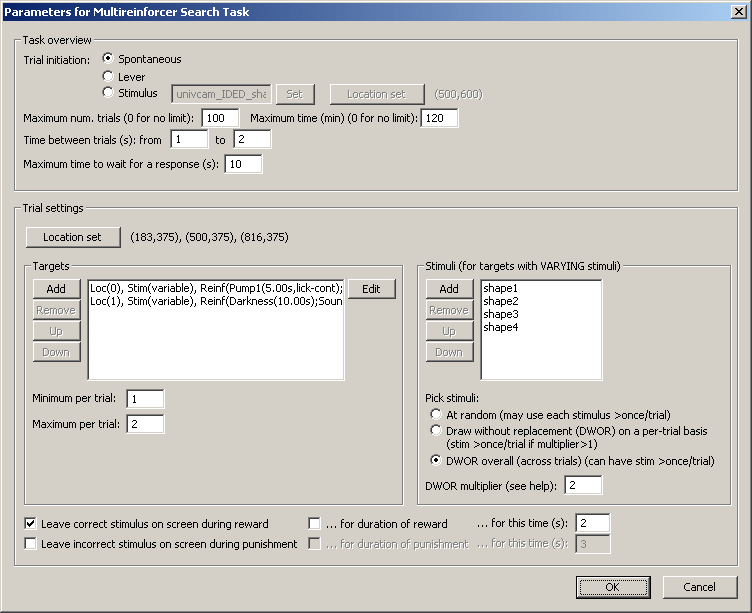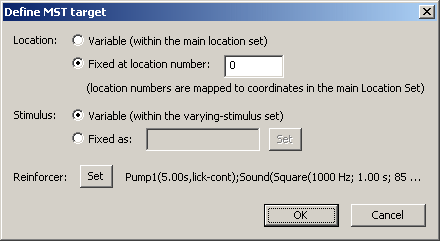Summary
Subjects must choose between several targets; some will provide reinforcement if selected. The relevant dimension may be the stimulus itself, or its location, or the combination of stimulus and location.
About the task
This task is currently RESTRICTED to specified laboratories.
Most distributions of MonkeyCantab do not provide it, will refuse requests to add this task, and will not load the parts of configurations that incorporate this task.
This task allows for the presentation and differential reinforcement of a set of targets. Each reinforcer has its own LOCATION (which may be fixed or variable); its own STIMULUS (which may be fixed or variable, though a target may not have both a variable location and a variable stimulus); and its own REINFORCER (which may be individually configured). On each trial, a selected number of targets are presented; the first response is noted, and the appropriate reinforcer delivered.
The task may therefore be used in several ways:
| • | locations all vary; stimuli fixed and different = visual discrimination |
| • | locations all fixed; stimuli fixed and all the same = spatial discrimination |
| • | locations all fixed, stimuli variable = harder spatial discrimination |
| • | locations all fixed; stimuli fixed and all different = easy (conjoint spatial+visual) discrimination |
Configuring the task

| • | Trial initiation may be spontaneous; requiring a lever response (see also Use with Dogs); requiring a response to a visual stimulus (whose appearance and location may be specified here). |
| • | Maximum number of trials. When the subject has performed this number of trials, the task ends. (You may specify 0 for no limit, though you must specify a limit on the number of trials, the time, or both. |
| • | Maximum time. When this time elapses, the task is terminated as soon as the current trial has finished. (You may specify 0 for no limit, though you must specify a limit on the number of trials, the time, or both.) |
| • | Time between trials. Specify a minimum and a maximum intertrial time (they may be the same). The actual time is chosen with a rectangular probability distribution within these values. The time between trials starts after any reward or punishment from the previous trial has finished. |
| • | Maximum time to wait for a response. Once stimuli have been presented, this is the time that the program will wait for a response before abandoning the trial as an omission. |
TRIAL SETTINGS
| • | Location set. Choose the Locations used by this task. In what follows, these locations are referred to by their number within this set. |
Targets
| • | Specify the target list. Targets are configured as follows. Note that a target cannot have a variable location and a variable stimulus, and two targets cannot share the same fixed location; all other combinations are possible. |

| • | Choose the minimum and maximum number of targets per trial. |
Stimuli (for targets with VARYING stimuli)
| • | Specify a list of stimuli to be used by targets with varying stimuli. |
| • | These stimuli may be picked at random; or by drawing without replacement (DWOR) starting afresh each trial; or using DWOR but maintaining the draw-from list across trials until it is empty. For DWOR systems, specify the DWOR multiplier. See DWOR for more details. |
OTHER
| • | Leave correct stimulus on during reward? (etc.) When the subject responds, the correct stimulus can be left on the screen during reward, and/or the incorrect stimulus can be left on during punishment. These stimuli can either be left on for the duration of the reward/punishment (as specified in the General Parameters), or you can specify how long to leave them on the screen for. |